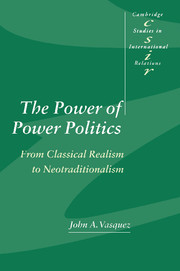Book contents
- Frontmatter
- Contents
- List of figures
- List of tables
- Preface
- Introduction
- Part I The Original Text: Classical Realism and Quantitative International Politics
- Part II Neorealism and Neotraditionalism: International Relations Theory at the Millennium
- 9 Retrospective: neorealism and the power of power politics
- 10 The promise and potential pitfalls of post-modernism: the need for theory appraisal
- 11 The realist paradigm as a degenerating research program: neotraditionalism and Waltz's balancing proposition
- 12 Mearsheimer's multipolar myths and the false promise of realist policy prescriptions: the empirical inaccuracy of the realist paradigm
- 13 Challenging the relevance and explanatory power of the realist paradigm: the debate on the end of the Cold War
- 14 Conclusion: the continuing inadequacy of the realist paradigm
- References
- Name index
- Subject index
- CAMBRIDGE STUDIES IN INTERNATIONAL RELATIONS
14 - Conclusion: the continuing inadequacy of the realist paradigm
Published online by Cambridge University Press: 22 September 2009
- Frontmatter
- Contents
- List of figures
- List of tables
- Preface
- Introduction
- Part I The Original Text: Classical Realism and Quantitative International Politics
- Part II Neorealism and Neotraditionalism: International Relations Theory at the Millennium
- 9 Retrospective: neorealism and the power of power politics
- 10 The promise and potential pitfalls of post-modernism: the need for theory appraisal
- 11 The realist paradigm as a degenerating research program: neotraditionalism and Waltz's balancing proposition
- 12 Mearsheimer's multipolar myths and the false promise of realist policy prescriptions: the empirical inaccuracy of the realist paradigm
- 13 Challenging the relevance and explanatory power of the realist paradigm: the debate on the end of the Cold War
- 14 Conclusion: the continuing inadequacy of the realist paradigm
- References
- Name index
- Subject index
- CAMBRIDGE STUDIES IN INTERNATIONAL RELATIONS
Summary
One of the major conclusions of the original text was that research guided by the realist paradigm was not producing strong statistical findings. Continual research was not resulting in a cumulation of knowledge. One of the reactions to this was to reinforce the already existing belief (see Bull 1966) that quantitative analysis was a technique that would not yield much of significance. The legitimacy of the messenger was questioned and the message's authenticity rejected.
As noted in the concluding chapter of the original text, this is an ad hoc explanation that serves to protect the paradigm by dismissing discrepant evidence of a certain sort. While persuasive to those who do not like quantitative analysis, the argument in itself does not provide an adequate test of the claim the ad hoc explanation is making. To do that, two obvious tests logically need to be conducted: one that would control for the paradigm to see if nonrealist hypotheses did as poorly as realist hypotheses and a second that would control for the method to see if realist hypotheses investigated by traditional analysis produced research conclusions markedly different from those produced by quantitative analysis. The original text did provide a preliminary test of the first, which found that nonrealist hypotheses do proportionately better, albeit the sample size for nonrealist hypotheses was small.
The study in Part II has been intended to see whether using traditional analyses provides better research results for realist propositions.
- Type
- Chapter
- Information
- The Power of Power PoliticsFrom Classical Realism to Neotraditionalism, pp. 369 - 386Publisher: Cambridge University PressPrint publication year: 1999



